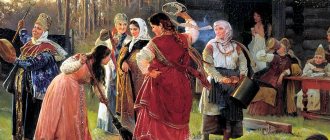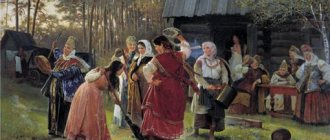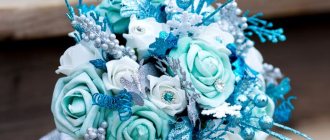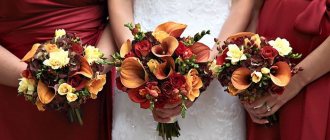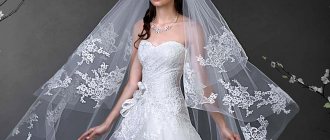Story
Content
Russian folk wedding dress has a centuries-old history. In the old days in Rus', the bride had to have four outfits:
- for dancing;
- for wedding;
- for engagement;
- for celebrations.
It is noteworthy that the wedding attire of ancient Russian peasant women did not differ significantly from the attire of noble girls. Moreover, the bride was required to sew her wedding dress herself. Even a noblewoman or a merchant's wife, before her wedding, sat down to needlework and made herself a wedding suit - rich families or not, it no longer played a role here.
The reign of Peter I made its own adjustments not only to the policies of Russia, but also to the customs of the country. Traditions, rituals and ceremonies changed. All segments of the population began to follow European fashion, and brides began to wear dresses similar to those worn in other countries.
The fashion for the traditional Russian wedding suit gradually faded away. But today it is again popular among newlyweds. Perhaps a completely modern girl would not risk repeating an old outfit. But certain details of jewelry and traditional decor in the wedding look are present in the clothes of many brides.
The sundress was the basis of the attire. It was decorated with gold and silver embroidery, decorated with pearls, beads and braid of bright colors. The wealthy newlywed shone in a sundress trimmed with valuable fur. The girl looked rich in a beautiful wedding dress. It should be noted that it was not so easy to be in such an image all day, since it weighed a lot due to the abundant decoration.
On top of the sundress was worn a soul warmer, embroidered with gimp or national ornaments. And skirts were worn under the sundress to add volume to the outfit.
Particular attention was paid to headdresses - kosnik, povoinik, kokoshnik, magpie. Each of them had its own meaning and was richly decorated with pearls and gimp. And pearl kokoshniks were considered a family heirloom, they were passed down from generation to generation.
Royal fashion
If white is the color of death, then how did the tradition of wearing a white dress come about? Some historians believe that Anna of Austria started this wedding fashion. As a representative of the famous royal family of the Habsburgs, Anna was the daughter of the Spanish king, and at the time when she was going to be married to the French monarch Louis XIII, Spain and France were on the brink of war. Anna did not want this marriage and was openly afraid that her stay in a foreign land would end in death, so she chose a white dress for her wedding with Louis. The courtiers regarded this as extravagant Spanish taste, because the dark-skinned girl in white was incredibly beautiful and looked like a cake.
And two centuries later, breaking tradition, Alexandrina Victoria, Queen of Great Britain and Ireland, married Albert of Saxe-Coburg-Gotha in a white dress. But this was already a tribute to fashion - by that time ancient Roman and ancient Greek culture was being rediscovered in Europe. All noble houses admired the beauty and laconicism of the marble sculptures of the Greeks and Romans in long white robes. At that time, archaeologists did not suspect that the statues had once been painted, and traces of paint simply did not survive on them.
After the wedding of the Queen of England, all her female subjects wanted to be sure to wear white at their own wedding. This trend quickly spread throughout Europe, including Russia. At first, only high-born Russian noblewomen who spent their entire lives in Europe got married in white dresses. And then, imitating them, representatives of other classes decided to leave the annoying sundress to illiterate peasant women. It was prestigious and fashionable to get married in a church in a long white dress, if, of course, the bride’s family had the money to order it abroad or to local foreign dressmakers. And since then, little has changed.
Peculiarities
Russian style embroidery is considered a distinctive and probably the most popular feature of the modern wedding look. Also in fashion are traditional jewelry that has come down to us from ancient wedding decorations.
The old Russian fabric from which the wedding dress was made deserves special attention. In the old days it was made from wool or flax. Wealthy families of ancient Rus' prepared velvet, brocade and silk for wedding ceremonies. Therefore, the modern bride can confidently choose these luxurious materials for her Russian style wedding dress. Another special feature was that several belts were worn at once.
Thanks to the talent of Russian needlewomen, even modest linen outfits looked expensive and rich in ancient times due to exquisite decor, embroidery and lace.
What did the bride's wedding costume consist of in Rus'?
The largest number of cultural reminders about wedding events exists from the times of Kievan Rus. When Christianity was adopted, lovers began to openly celebrate the creation of a new family; this day was given special significance. So, at this time, folk costumes began to develop, which served as the bride’s wedding dress and the groom’s outfit. They always combined the richest fabrics, patterns, and folk symbols.
All wedding folk costumes in Rus' usually included a shirt. It could be long or short, like a modern men's shirt. Only certain parts of this element of clothing peeked out from the sundress, which is why such a shirt was sometimes called “sleeves.” These parts were embroidered with the most beautiful patterns. On the shoulders of such wedding folk shirts there were special inserts that were decorated separately. The fundamental difference between an ordinary everyday outfit and a wedding one is the richness of the second one. They couldn’t even come up with any white dresses back then.
The shirt was worn under a wedding sundress and was an integral part of folk attire. It was sewn from 4 pieces of natural linen fabric (occasionally from 2) and embroidered with silk threads. Multidirectional stitches were often used, which create the effect of a “living” ornament. The pattern itself could have a geometric format (sharp corners, endless lines or stripes) or a natural one (flowers, curls, leaves). This was chosen by the bride herself, as she did all the work.
Nowadays, a Russian folk costume for a wedding must also have an embroidered shirt, but it already has a modified appearance - any colors can be chosen, machine work is possible, not hand-made. The bride does not need to sit over her hoop at night to be beautiful at the wedding - she should go to large stores and find a suitable wedding shirt.
The wedding dress was sleeveless, with narrow or wide straps. At the beginning of the development of ceremonies, the sundress was wedge-shaped - it consisted of several parts, expanded towards the bottom. And later it began to transform into a straight cut version. But in both cases, the waist was not emphasized; the sundress was loose and hid all the parameters of the female body. Moreover, the material was so dense that even the woman’s form was difficult to discern.
Another thing now is that for a wedding celebration you can wear the most fitting outfits that slim and reveal any part of the body. If you choose a folk style, then the format of the sundress should be preserved and dressed as it was customary by our grandmothers. Make sure that the patterns on such a wedding dress correspond to your preferences - every pattern in the people means something and it is very important that these statements are combined with your worldview.
This part of the peasant decoration also took place in the wedding dress. The shape of the apron is a little similar to a modern apron and its purpose was the same. This item of clothing was also embroidered, but not as thickly as a shirt or sundress. It was allowed to be short with ties behind the back or long - across the neck. Different options for aprons allowed each newlywed to stand out and be special. The girls showed their thriftiness in their ability to make a wedding dress.
For a modern wedding ceremony, you can prepare an apron, but it is not recommended to wear it throughout the entire event. There is only one reason for this - such an apron can hide the beauty of the sundress itself, since it is worn over it. It is better to use an apron for a certain part of the photo shoot, but not at the time of the wedding or celebration. Please note that many provinces did not have the tradition of wearing aprons with sundresses at all - which is why it is not mandatory at a wedding.
One or more belts
The belt has always been used to emphasize the waist and beautiful female forms. It is also a functional device - it holds clothes on the figure. Brides sometimes used such belts at wedding ceremonies. They were embroidered, very thick and could be tied in different ways, since each one had a different length. Some newlyweds wore several belts at once in order to stand out and change their wedding attire.
There are several ways of tying - with or without a knot, with a bow or with “twisted ends”. The bride can wear the belt in different places: under the chest, on the belt. It all depends on which elements of the female body need to be emphasized and which ones need to be hidden. For thin bodies with wide hips, it is better to tie the belt at the waist, and if you want to visually enlarge the chest, then the belt should be fastened under it.
Petticoats
This element of wedding clothing does not perform such a big task, but in ancient times it was very often used. The bride could wear a petticoat to bed on her wedding night. The technique for its implementation was the same as for part of the sundress: wedge-shaped or straight cut. The bottom of such an item of clothing was embroidered with silk threads, and the upper part was sewn with elastic without fasteners.
Who is it suitable for?
Original wedding dresses in Russian folk style will suit any girl. In the old days, there were completely different criteria for assessing the beauty of a bride. But both then and now, outfits in the national version look stylish and luxurious, decorated with embroidery, thread, pearls, furs and openwork lace.
The cut of a wedding dress, close to ancient fashion, will successfully hide the features of a woman’s figure. Therefore, the national style should be chosen by girls with a curvaceous figure and, conversely, those who are excessively thin.
Choice of color, fabric and cut
The styles of wedding dresses in the Russian style are full of variety. Fashion designers were able to adapt even an elegant year model to it. When choosing a cut, the bride will not have to take into account the nuances of her figure. Slavic wedding clothes will decorate a girl with any parameters.
Common styles of Slavic wedding dresses include:
- A-silhouette;
- straight cut;
- lush;
- shortened options.
The material for sewing an outfit in Russian folk style should be linen or cotton. Synthetic fabrics will be inappropriate. You can use lace for decoration.
The main color in a wedding dress can be red or white. The decor is made in golden, blue, red or green tones. It is advisable that color combinations be contrasting. This will make the image bright and festive.
Styles
Whatever style of Russian-style wedding dress the bride chooses, she will still be beautiful and elegant in this original look. The combination of red embroidery with a snow-white outfit of light fabric looks very advantageous. In such a wedding dress of ancient and modern style, the girl will look elegant and stylish.
- Godet. A traditional Russian cape with a woven belt harmonizes well with a godet-shaped dress.
- Provence. The French elegance of the outfit was decorated with lace framing the dress.
- Sundress. The traditional classic Russian sundress was decorated with gold decor. This attribute will not only hide the bride’s plumpness, but will also emphasize the modern details of the wedding dress.
- Soul warmer. Today, this vintage outfit can be replaced with a stylish jacket. In those days, soul warmers were embroidered with gold threads and decorated with beads. It will look good on a formal wedding dress. This way you will have an elegant two-piece wedding suit.
When choosing the style of a wedding dress, it is not necessary to completely copy the outfit of past centuries. No one forces the bride to wear a festive kokoshnik, a long-sleeved shirt or a wide sundress. One element borrowed from the classic national dress is enough. This could be an ornamental belt, a lace cape, or embroidery along the hem of a skirt using white and red threads.
Three dresses for Cinderella
Usually the bride had several outfits. One was supposed to be worn at a bachelorette party, the other before marriage, and the third after. Sometimes the dress that the girl wore before the wedding was made black. It symbolized the death of the bride for the old family and old life. After the wedding, the newly-made wife was dressed in a bright sundress, signifying the joy with which the girl entered a new life. The best attire was reserved for the second day of the wedding, with dark, rich shades often chosen. The embroidery on the sundress served as a talisman, so the patterns were carefully selected.
The wedding dress was traditionally red. (culture.ru)
Accessories
If you have chosen a Russian-style wedding dress, you need to carefully consider all the accessories. Jewelry on the neck or on the arms should be harmoniously combined with the outfit and emphasize, and not interrupt, its style. The main thing is not to overdo it with decorations and decor. Focus on one accessory.
- Shoes. In combination with a wedding dress in a traditional style, it is advisable for the bride to choose shoes without pointed toes and high heels. White or red boots, which have always been present in Russian national attire, will look stylish.
- Belt. A belt on a wedding dress can advantageously emphasize the slimness of a figure or hide its flaws. A belt tied in a knot according to Russian tradition, with intricately twisted ends, will look very original. Previously it was believed that the richer the bride, the more belts she should wear. But a modern girl can easily get by with one made of dense material. The belt, long or short, is embroidered with national ornaments or decorated with stones.
- Crown. A bright crown will add color to the bride’s national costume. Juicy flowers will look good with a dress of any style and style. They are suitable for brunettes, blondes, brown-haired women.
- Kosnik. In the old days, the newlywed decorated her hair with a braid - beautiful ribbons with embroidery, decorated with pearls, lace and pendants. This type of jewelry is also suitable for a modern bride. It will become the highlight of the outfit, its bright and unusual detail. You can also decorate your head with an original kokoshnik.
- Veil. A veil was always placed on the bride's head. Made in the Slavic style, it looks harmonious with a plain, modest wedding dress. The veil can be of any length, but it must be bright and catchy.
- Cape. For a Russian wedding look, both a lace and a fur cape are suitable. It will not only be an original decoration of the outfit, but also a practical accessory, as it will protect the bride’s shoulders from the cold and wind.
- Flowers. Russian weddings have always been colorful and rich in colors. Therefore, a juicy bright bouquet in the hands of the bride will be in harmony with the decorative elements of the outfit. It doesn't have to be big and fluffy. Modest wildflowers will emphasize the grace of the girl, the style of her outfit and the national flavor.
- Hairstyle. Traditional Russian braid or large curls - these were the ones preferred by brides in the old days. You can also weave fresh flowers into your hair, arranging them in a wreath. The ideal smooth hairstyle will look elegant and stylish if it is decorated with buds of bright colors.
Styles by country
Wedding dresses in folk style look especially original and bright.
Designers transfer the bright features of each country and people into modern dresses, creating something unique with a touch of originality.
In Ukrainian
Brides who want brightness and lightness can pay attention to dresses in the Ukrainian style. The bodice and hem in this style are embroidered with all kinds of colors, decorated with rhinestones and beads
Scarlet poppies, cornflowers and daisies adorn brides, focusing on their youth and innocence. The style of such a dress can be any.
In Slavic
A wedding dress in the Slavic style can be recognized by the following details:
- puff sleeves;
- wide contrasting belt;
- ornament in blue, red, silver or gold colors.
The ethnic style dress is made of linen and cotton. Such models are lightweight and comfortable. If only subtle notes of originality are needed, designers decorate dresses made from modern fabrics with ornaments and wide belts.
In the eastern
Designers, inspired by the beauty of the East, transfer its motifs into wedding dresses. Egyptian, Indian and Arabic patterns decorate the closed styles of dresses.
The sleeves of such models are closed and decorated with lace, and some styles even resemble the outfits of dancers with a low waistline and a lace bodice, while the belly is covered with thin translucent fabric.
In Spanish
Dresses in the national Spanish style resemble the costumes of flamenco dancers. The models, made in white, are decorated with voluminous flounces on the shoulders and hem.
In addition to the pompous frills and flounces in the Spanish style, you can see simpler models with open shoulders in the Carmen style and a straight, feminine silhouette.
In English
English dress is distinguished by restraint and adherence to canons. So, the dress should have maximum length and emphasis on the waistline.
The fabrics for this outfit are matte, without decoration in the form of rhinestones and embroidery. Lace and patterns in this style can only decorate the bride’s veil and gloves.
In Italian
Italian style in the image of a bride is always romantic and feminine. This style is inspired by the hourglass figure and accentuates it with full skirts, flared styles and plunging necklines.
The color of the dress in this style should be white. Bright accents in the form of red and green ribbons are allowed in the outfit. An addition to the Italian look will be a bouquet, always made of roses.
In French
French style can be recognized by the elegance of its style. Models that highlight the silhouette contain a minimal amount of jewelry. One bright detail in the form of a wide belt of a rich shade or a bow is enough to maintain the look.
Another type of French wedding fashion is the cancan style. It consists of dresses that are short in the front and long in the back. It is worth saying that this style is especially comfortable.
In Greek
The style of the Greek goddesses is represented by dresses with a high waistline, an accentuated bodice and a loose hem. This style is decorated with all kinds of draperies made of delicate flowing fabrics.
The rebirth of white
Interest in ancient culture, which marked the beginning of the Renaissance, was reflected not only in the art of that time. The fashion for snow-white wedding dresses has also returned. Antique marble statues found during excavations dictated the color, the style (A-line, no corset), and even the fabrics - flowing and translucent. One of the first brides who dared to walk down the aisle in a white dress was Mary Stuart in 1559.
It was a satin dress embroidered with pearls. The queen threw a robe decorated with precious stones over her shoulders. And instead of a veil, as befits her rank, she put on a gold crown inlaid with diamonds, emeralds and rubies. A little later, in 1572, nineteen-year-old Margaret de Valois, Queen Margot, wore a light dress. In her Memoirs, she devoted several lines to describing this outfit. “I was dressed like a king, wearing a crown and an ermine cape covering my shoulders, all sparkling with the jewels of the crown.”
But Queen Victoria is still considered the trendsetter for the white wedding dress. Only after the queen appeared before the groom in a fluffy cream dress made of Spitalfields satin in the chapel of St. James's Palace on February 10, 1840, did this color become the standard for a long time. The queen's outfit was decorated with lace flounces on the neck and sleeves, as well as a five-meter train. This style is still considered the gold standard for weddings.
The popularity of the snow-white dress in European fashion is explained not only by Christian traditions, where the color white represents chastity. More everyday factors also influenced the tastes of brides of the 19th and 20th centuries. For example, the appearance of white soap (until the 20th century, it was usually brown), which added the symbolism of health and cleanliness to the associative range. The invention of photography also played a role. The light dress looked more flattering in black and white photographs than other shades.
European influence
Recognizable styles, but new motifs
In this case, the foreground is an A-shaped outfit, decorated with embroidery, lace, and frills. Most often it is decorated in expensive colors, decorated with gold thread. The degree of luxury in it may vary. So, only fabric, such as silk, can be responsible for luxury in the a la russe style. The outfit is able to shine to the fullest, having all the above features in its design and even fur trim in addition. This will not be at all overkill for À LA RUSSE (a la rus).
This dress appeared in Russia under the influence primarily of the Victorian era. The mixture of European cultures made it possible to introduce a V-shaped closed collar into ala Rus. A high stand-up collar, ruffles and many other feminine elements were also added.
A previously uncharacteristic color scheme has also been added. These are shades of gray-ash, pearl, blue, lilac, pastel shades of yellow, pink and the like.
A la russe for the evening provides luxury in everything
It is appropriate to wear such decorations only for celebrations of a special nature or to wear them for evening outings. Such outfits can well act as a wedding set if you like an alternative to the white classics. And it would be appropriate to dress up as a guest for a wedding or other event with a large number of guests.
Outfits ala Rus from Giambattista Valli for 39,200 and Self-Portrait for 44,960 rubles in the LUXXY catalog
The catalog of the LUXXY resale platform presents a wide selection of evening, formal and everyday outfits for all occasions. Choose the look of your dreams in a la russe style.
By the way, if you like to study various stylistic trends in clothing, we suggest you look at the article about Korean modern fashion. This is a very unusual and colorful destination.
Well, we congratulate you on Russia Day and wish you a wonderful time with LUXXY
_______________________________ Find premium brand products with discounts up to 90% here:
Cabbage style
A distinctive feature of the Russian national costume is its multi-layered nature. The everyday suit was as simple as possible, it consisted of the most necessary elements. For comparison: a married woman’s festive costume could include about 20 items, while an everyday costume could include only seven. According to legends, multi-layered, loose clothing protected the hostess from the evil eye. Wearing less than three layers of dresses was considered indecent. Among the nobility, complex dresses emphasized wealth.
Peasants sewed clothes mainly from homespun canvas and wool, and from the middle of the 19th century - from factory-made chintz, satin and even silk and brocade. Traditional outfits were popular until the second half of the 19th century, when urban fashion began to gradually supplant them.
We thank the artists Tatyana, Margarita and Tais Karelin - laureates of international and city national costume competitions and teachers - for providing photographs.
Source
Retro
Retro style provides us with a huge selection of models, since it begins in the twenties of the last century and ends approximately 60 years later.
The twenties were a daring period of glitz, extravagant feathers, abundance of beads, and wedding dresses with missing sleeves.
But the thirties are characterized by restraint and global crisis; this is necessarily a long dress with a train and a cutout on the back, complementing the image.
The brides of the forties exuded tenderness and light charm; tulle and chiffon, open shoulders were coming back into fashion, but most often sleeves were added to the dress.
The retro style also includes the new look trend (50-60s). Wedding dresses resemble an hourglass: an ankle-length dress, a full skirt, emphasized breasts and a slightly narrowed waist.
Lush, cropped models are well suited for a fun wedding in the style of a dude.
Colors, fabrics, cuts
The color scheme for wedding dresses in the Slavic style includes the entire spectrum of shades, but the predominant ones are pure and rich:
- red;
- blue: from sky blue to dark cobalt;
- gold;
- white;
- green;
- silver.
The imagination of designers is unlimited. As a wedding option, they are ready to offer a dress with blue-blue Gzhel patterns or an outfit boldly decorated with red, black and gold Khokhloma. On the catwalks you can see the wedding image of a merchant’s daughter, wrapped in luxurious furs and a Pavloposad scarf, or a slender schoolgirl in a fitted gray-blue dress with a muff in her hands and soft felt boots. For a wedding dress in the Russian style, natural fabrics are chosen, the texture of which depends on the style: from affordable cotton and linen to luxurious satin, chiffon, silk, shantung, brocade, taffeta, organza and original two-layer quilted fabrics.
The ethnic flavor is emphasized by the characteristic features of the cut:
- flashlight sleeve;
- voluminous skirt with a long train;
- wide embroidered belt;
- embroidered bodice;
- hem flared from the waist.
A Russian style dress has the same hem length on all sides. As a rule, the skirt reaches the floor or mid-calf. The style can be any - flared, tapered, straight, A-shaped.
